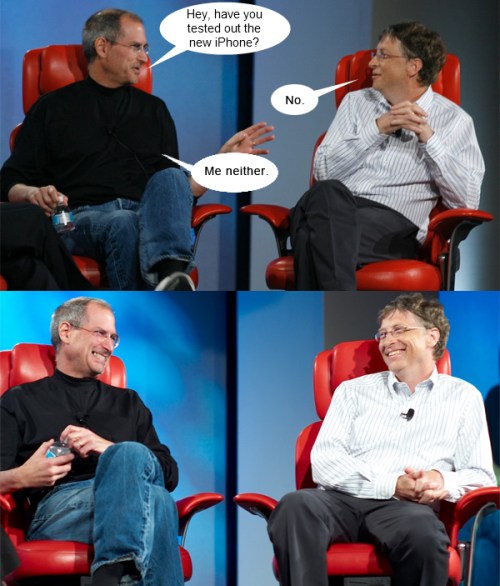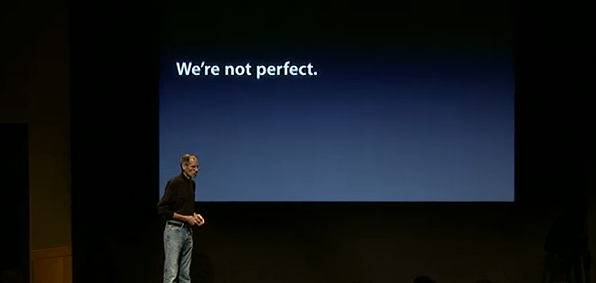Well, that’s not true. But what Jobs called Antennagate at today’s press conference is more than just the design flaw in the iPhone 4 they insisted was a non-issue. It’s a design flaw with the entire way the issue was handled — by them and by us. The feeding frenzy around the iPhone 4 has been a months-long affair, for a combination of two reasons: one, that Apple has a unique position in tech coverage, and two, that controversy generates traffic. The result is outrage, confusion, expenditure, flamewars, and everything else that’s been happening online since the launch.
Sorry about that. We’re not perfect.

See, as you may know, Apple enjoys a bit of a coverage bias here and elsewhere on the net. Why is that? You know why, for the most part: sexy products, charismatic leader, a whiff of elitism. They’re fun to write about and many people enjoy reading about them — that’s enough for us. So it shouldn’t come as a surprise that, when a design flaw, plain for all to see, was detected in what was heralded as the best smartphone ever to be released, the response in the tech community — our response — was mixed and misleading.
I say mixed because Apple coverage seems to be opinionated far more than other coverage, anywhere you look on the net. There is very little emotion in reporting on HP or Palm — perhaps it is because, as MG suggests, Apple works hard on building an emotional bond with its customers, something which its detractors see and abhor. Whether that’s the case or not, Apple news is often delivered with a slant. And I say misleading because in some ways, how Antennagate (which I am going to stop referring to as such; “-gate” terms are overused) was reported exposed many of the weaknesses in the online reporting structure of which we are a small part. Let’s get into that.
Apple’s ubiquity in web culture usually works in their favor: a press conference with a couple hundred people becomes an internet-wide festival of love and hate. Of course, part of that is their knowing how to put on a presentation, the value of which is something many companies deeply underestimate. Even when revealing the iPhone’s flaws and return rates, Steve treated it like he was revealing new flavors of candy. But the coverage is unstoppable and in a way, free. A major part of advertising is getting people talking about your product; with Apple, people are so primed to talk that all they have to do to advertise is show a picture with the name of the product. Considering Apple’s marketing reach, the excesses and Jobsian quips that do routinely set the internet on fire are mercifully few and far between.
In the last few weeks, however, that self-same ubiquity has been Apple’s worst enemy. Imagine if everything you did propagated, memelike, to the farthest corners of the internet, where even the die-hard Apple hater must acknowledge every announcement, even if it’s just to criticize it (something I enjoy occasionally). After using that power judiciously and deliberately for years, the inevitable finally happened: they dropped the ball — and it dutifully propagated. When your failure becomes a meme, you’re cooked.
For the record, these were my two contributions:


The signal drop heard ’round the world was followed by many more reports of launch issues. It was rough, and because of the way the internet has set itself up to instantly propagate exactly this kind of thing, soon people were hearing about iPhone 4 issues before they even knew there was an iPhone 4. The launch problems became a bigger story than the launch. Why? Because we liked it that way.
The appetite for this kind of thing is bottomless. Reasons for interest include fanboyism, professional interest, idleness, schadenfreude, legitimate concern… there was something for everybody. Then Apple, knocked off-balance by their own unpreparedness, gave a response that simply made things worse. “Non-issue. Just avoid holding it in that way.” I can’t think of a response that could have garnered a more comprehensively varied response. Shock! Defensiveness! Rationalizing! Minimizing! The circus became a feeding frenzy. And then the official statement, in which they revealed that iPhones had been using a ridiculously inaccurate signal display for years, and that they were going to make the bars bigger? My god!
So Apple was far from innocent in this whole affair, right up to the non-apology given by Steve today. Their only mistake, Steve implied, was a visual element that caused users to involuntarily ruin their own signal. Steve could talk his way out of a sunburn, as the saying goes, but not this time. Scott noted when we were chatting about this that according to Apple, the iPhone is unlike every other phone on the market — except when there is a problem, at which point it’s just like every other phone on the market. That said, I’m glad they decided to give out bumpers, and of course you can always return the phone for a full refund, so as far as I’m concerned, customers are completely provided for. Class-action lawsuits are pending but I wouldn’t hold out much hope for a settlement.
But were we innocent? One could say we just did our jobs, and wrote up what was going on. We detailed it step by step. Was that the extent of our responsibilities, though? If it was, then Twitter did our job as well as we did, and maybe better. I wrote a while back: “Real time, real discussion, real reporting – choose two.” Looking back on all the coverage, there was a lot of real-time discussion, but almost no reporting at all. Some very valuable input came from Anandtech, when Anand systematically tested the attenuation caused by shorting the antenna, but by and large it was theories, counter-theories, rumors, and fabrications getting multiplied and amplified by blogs like this one. Even ostensibly reliable outlets in the old media posted garbage of every kind. Publishing rumors is, of course, a valuable part of the job, since many are true or end up resulting in interesting discussion. I’m glad we posted all the things we posted. But I also think Steve is right: this was a pretty serious mountain-molehill situation.
The antenna problem is real, of course. How much of a problem it really is — that’s harder to say. Although I would normally say that it’s under-reported in those Apple statistics, that probably isn’t the case here. After all, this is probably one of the most widely-publicized product launches in history, partly because of the huge amount of attention given to this very flaw. If a user has an iPhone, they are almost certain to know of the issue. And if they know of it, they are almost certain to notice it when it happens. Although as Apple and others have noted, it mainly occurs in areas with marginal reception, so many people may find later that they are death grip sufferers and didn’t know it when they take a trip to the boonies. For this reason I’d suggest getting a case even if you don’t really need it where you live.
But those numbers: half a percent of iPhone 4 users complaining? 1.7% return rate? Nearly identical call drops to 3GS? Out of 3 million users, that’s around 30,000 — not a trivial number by any means, but in retrospect, does it justify the international wave of mockery? It ain’t exactly Side Talkin, after all: 2.9 million people seem to be happy with their phones.
The Point

What am I getting at here? Well, I think this whole debacle demonstrates the power of the Internet to report in the wrong way, as opposed to the Tiger Woods incident, which I think demonstrated the Internet’s strengths (though it also resulted in my writing the “Choose Two” article I mentioned). When the event is what matters (e.g. Tiger Woods crashing his car with his wife beating on the windows), and updates on the granularity of minutes are warranted, the Internet is the perfect medium. But by applying that toolset to something it is totally unsuited for, we found ourselves groping in a dark and crowded echo chamber, grasping at factual straws and thrusting them into the faces of everyone we encountered. How little it accomplished! Apple is temporarily humbled, but they would have been one way or another. But they have the benefit of being unfairly set upon, of being able to quote hundreds of articles spewing FUD and unconfirmed nonsense — after all this, they get to play the victim card! That’s the real Antennagate.
Unfortunately, the solution is an impossible one. This is because the solution is discretion. Discretion and restraint are things that have more or less disappeared, since the benefits of being first and wrong outweigh the benefits of being late and right. The short-term benefits, I should say, in the form of traffic and popularity — very important metrics to the powers that be (advertisers and such). The long-term benefits of being a reliable source for news and analysis are becoming more and more difficult to discern, which is disturbing to me. Yet I still believe, and this whole thing has made me believe more, that perspective and discretion are as important as ever — and probably only as rare as they ever were to begin with. I’m not going to get all emotional on you here and say “oh no journalism is dying,” as if I know a thing about that, but let’s be honest: sometimes journalism can be pretty hard to find — even if you think you know where to look.
There you have it. I just wanted to put my own lid on this whole iPhone 4 thing, with the conclusions I’ve drawn from it. If it came off like Apple apologia, I don’t think you read closely enough. The way the world reports and is reported is going through all kinds of transitions, and one day I think that this whole thing and other stories like it are on their way to becoming case studies in Mass Communications 101.
